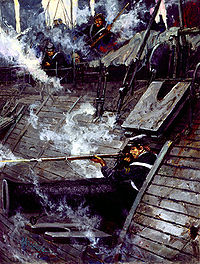The Confederates had fortifications, called Fort Darling, atop Drewy's Bluff that sat on the south/west bank, overlooking a key bend in the James, and offering a commanding view of the river. With the Confederate gunboat Virginia (formerly the Merrimack) out of the way, and Union troops now past Williamsburg, the Union flotilla probed Confederate defenses on this day. These included the famous Monitor and the Galena.

A Map of the Peninsula Campaign through May 1862 (including the action at Drewry's Bluff); Map by Hal Jespersen
The National Park Services battle summary can be found here:
http://www.cr.nps.gov/hps/abpp/battles/va012.htm
Here is the account at the Civil War Daily Gazette:
http://civilwardailygazette.com/2012/05/15/victory-against-the-galina-and-monitor-at-drewrys-bluff/
The battle did not unfold favorably for the Union -- the guns on the bluff, combined with the obstacles in the river preventing forward progress meant that the flotilla would be forced to withdraw. The NPS page on their facility at Drewry's Bluff (part of Richmond National Battlefield Park) gives the following description:
"The Federal squadron steamed around the bend in the river below Drewry's Bluff early on the morning of May 15. The force, under Commander John Rodgers, consisted of five ships. The ironclad Galena and gunboats Port Royal, Aroostook, and Naugatuck joined the famous Monitor to comprise Rodgers' force. At 7:15 a.m. the Galena opened fire on the fort, sending three giant projectiles toward the Confederate position.
The five Union ships anchored in the river below the fort. When Confederate batteries in the fort replied, the whole vicinity shook with the concussion of the big guns. Southern infantry lined the banks of the river to harass the sailors. On the Monitor, the rifle balls of the sharpshooters 'pattered upon the decks like rain.'
On the bluff the defenders encountered several problems . The 10-inch Columbiad recoiled so violently on its first shot that it broke its carriage and remained out of the fight until near the end. A casemate protecting one of the guns outside the fort collapsed, rendering that piece useless.
After four long hours of exchanging fire, the 'perfect tornado of shot and shell' ended. With his ammunition nearly depleted, Commander Rodgers gave the signal to discontinue the action at 11:30. His sailors suffered at least 14 dead and 13 wounded, while the Confederates admitted to 7 killed and 8 wounded. A visitor wrote that the Galena "looked like a slaughterhouse" after the battle. The massive fort on Drewry's Bluff had blunted the Union advance just seven miles short of the Confederate capital. Richmond remained safe."
The battle would have a unique link to the Marine Corps of both sides of the conflict -- for the Union, Corporal John F. Mackie would earn the Medal of Honor in the fighting on 15 May 1862. For the Confederacy, Fort Darling was the base of operations for the Confederate Marine Corps, and also the site of their Naval Academy.

US Corporal John Mackie on the Galena,
earning his Medal of Honor.
In you ever find yourself on the southside of Richmond, Virginia, a visit to the site of Drewry's Bluff and the remnants of Ft. Darling are well worth a visit. It is maintained as part of Richmond National Battlefield Park. More here: http://www.nps.gov/rich/index.htm
Live well!
No comments:
Post a Comment